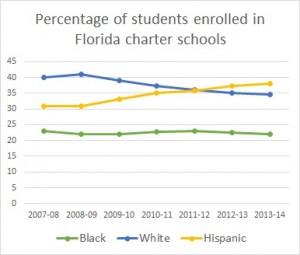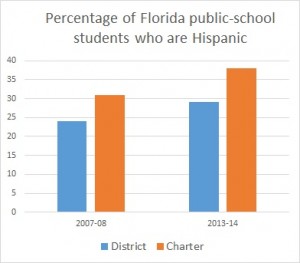
Hispanic students are fueling much of the growth in Florida’s public-school enrollment, but a trend within that trend has not received as much attention. They are disproportionately enrolling in charter schools, where they are now the largest racial or ethnic group.
The percentage of Hispanic students attending the state’s charter schools first surpassed that of white students in 2012-13. The next school year, it grew to more than 38 percent, compared to roughly 35 percent for white students and 22 percent for black students.
Some increases were to be expected. Hispanics account for much of Florida’s recent population growth, and a steadily rising share of public school students overall.
Their share of charter school enrollment appears to have grown more quickly.

During the 2007-08 school year, about 24 percent of students attending district schools were Hispanic. By 2013-14, that number had grown to more than 29 percent, but white students remained the largest ethnic group.
During the same period, Hispanics grew from about 31 percent of charter school students to more than 38 percent.
Surveys by the U.S. Department of Education, now almost a decade old, found Hispanics nationwide were slightly more likely than other racial groups to attend their zoned schools rather than a school of their choice.
Yet polling by the Hispanic Council for Reform and Educational Options suggests they are more likely to support charter schools and other school choice policies.
It seems conceivable, then, that there were Hispanic families who wanted more options than were available to them. For what it’s worth, Hispanics are also the largest ethnic group among students receiving Florida tax credit scholarships.
Looking more deeply at these trends might help shed light on what motivates families who favor charter schools and other options, and raise questions about whether the education system as a whole is keeping up with the growing diversity of the student population. We intend to explore those issues more deeply in future posts. In the meantime, see more charter school comparisons from the state Department of Education here, and our compilation of numbers here.


